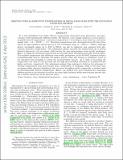DERIVING STELLAR EFFECTIVE TEMPERATURES OF METAL-POOR STARS WITH THE EXCITATION POTENTIAL METHOD
Author(s)
Frebel, Anna L.; Casey, Andrew R.; Jacobson, Heather; Yu, QinQin
DownloadFrebel_Deriving stellar.pdf (483.8Kb)
OPEN_ACCESS_POLICY
Open Access Policy
Creative Commons Attribution-Noncommercial-Share Alike
Terms of use
Metadata
Show full item recordAbstract
It is well established that stellar effective temperatures determined from photometry and spectroscopy yield systematically different results. We describe a new, simple method to correct spectroscopically derived temperatures ("excitation temperatures") of metal-poor stars based on a literature sample with –3.3 < [Fe/H] < –2.5. Excitation temperatures were determined from Fe I line abundances in high-resolution optical spectra in the wavelength range of ~3700-~7000 Å, although shorter wavelength ranges, up to 4750-6800 Å, can also be employed, and compared with photometric literature temperatures. Our adjustment scheme increases the temperatures up to several hundred degrees for cool red giants, while leaving the near-main-sequence stars mostly unchanged. Hence, it brings the excitation temperatures in good agreement with photometrically derived values. The modified temperature also influences other stellar parameters, as the Fe I-Fe II ionization balance is simultaneously used to determine the surface gravity, while also forcing no abundance trend on the absorption line strengths to obtain the microturbulent velocity. As a result of increasing the temperature, the often too low gravities and too high microturbulent velocities in red giants become higher and lower, respectively. Our adjustment scheme thus continues to build on the advantage of deriving temperatures from spectroscopy alone, independent of reddening, while at the same time producing stellar chemical abundances that are more straightforwardly comparable to studies based on photometrically derived temperatures. Hence, our method may prove beneficial for comparing different studies in the literature as well as the many high-resolution stellar spectroscopic surveys that are or will be carried out in the next few years.
Date issued
2013-05Department
Massachusetts Institute of Technology. Department of Physics; MIT Kavli Institute for Astrophysics and Space ResearchJournal
Astrophysical Journal
Publisher
Institute of Physics Publishing
Citation
Frebel, Anna, Andrew R. Casey, Heather R. Jacobson, and Qinsi Yu. “DERIVING STELLAR EFFECTIVE TEMPERATURES OF METAL-POOR STARS WITH THE EXCITATION POTENTIAL METHOD.” The Astrophysical Journal 769, no. 1 (May 20, 2013): 57.
Version: Author's final manuscript
ISSN
0004-637X
1538-4357